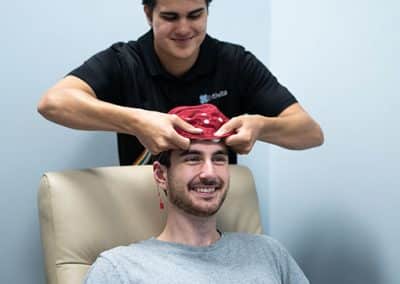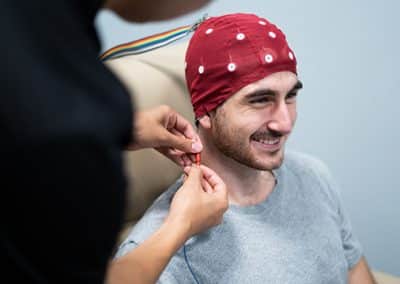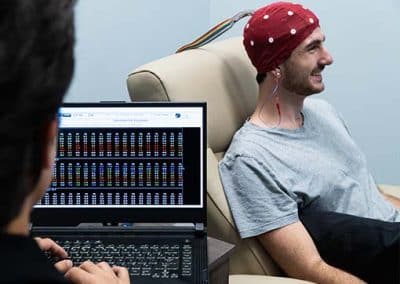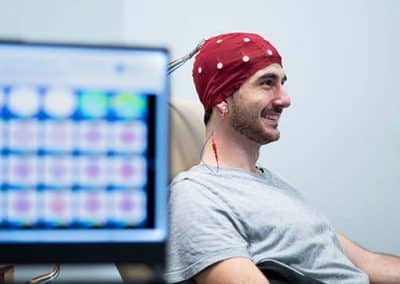Insomnia
HBOT- Hyperbaric Oxygen Therapy (HBOT) may help with insomnia by increasing oxygen delivery to the brain and improving brain function. HBOT enhances oxygen levels in the blood, which can improve brain tissue health and help regulate sleep patterns. It also has anti-inflammatory effects, which may reduce inflammation-related insomnia (1). Additionally, HBOT may regulate neurotransmitters like serotonin and dopamine, which are important for sleep, and reduce stress and anxiety by improving blood flow and oxygenation (2) . For those with brain injuries or conditions, HBOT can support brain healing and lead to better sleep.
Extivita Therapies for Insomnia:
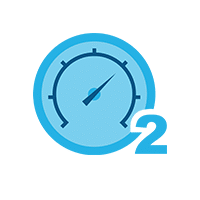
HBOT

IV Therapy

Infrared Sauna

PEMF Therapy
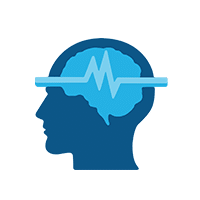
Neurofeedback
Neurofeedback Therapy for Insomnia:
Insomnia has significant effects on the brain, impairing cognitive functions like attention, memory, and decision-making, while also disrupting emotional regulation (3). Chronic sleep deprivation increases the risk of cognitive decline and neurodegenerative diseases, including Alzheimer’s and Parkinson’s (3). One key issue is that insufficient sleep hampers the brain’s ability to clear metabolic waste, including beta-amyloid—a protein linked to Alzheimer’s. This buildup of waste products further raises the risk of these conditions (4).
Neurofeedback is a promising, non-invasive technique that can help treat insomnia by training the brain to regulate its activity. It works by monitoring brainwave patterns in real-time and providing feedback to encourage the production of relaxing brainwaves, which are crucial for good sleep. Neurofeedback helps restore healthy sleep cycles, reduces stress and anxiety, and promotes more restful sleep, offering a drug-free alternative for managing chronic insomnia(5).
Nutritional IV Therapy for Insomnia:
Myers cocktail and NAD+ infusions may help patients with insomnia. Myers Cocktail and NAD+ infusions may offer potential benefits for patients with insomnia by addressing underlying factors such as inflammation and cellular health. The Myers Cocktail, which includes vitamin C and magnesium, can help reduce inflammation—a condition often linked to insomnia—by neutralizing free radicals and lowering oxidative stress (6). Magnesium, another key component, is known to promote relaxation and improve sleep quality by calming the nervous system (7). NAD+ infusions enhance cellular energy production and repair processes, potentially benefiting sleep by supporting the function of mitochondria and reducing neuroinflammation (8). NAD+ also plays a role in regulating the circadian rhythm, which could help stabilize sleep patterns (9).

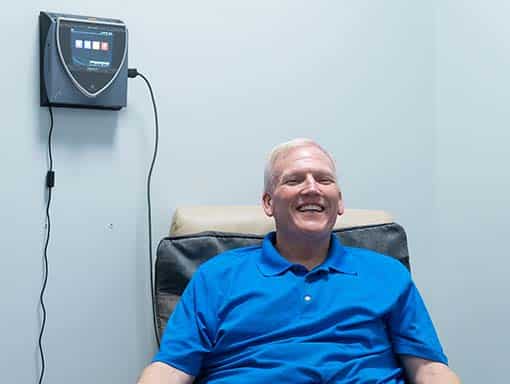
Pulsed Electromagnetic Field Therapy for Insomnia:
Pulsed Electromagnetic Field (PEMF) therapy may help modulate brain activity and neurochemical processes related to sleep regulation, making it a promising non-pharmacological option for managing insomnia. PEMF therapy can benefit patients with insomnia by promoting relaxation, improving sleep quality, and reducing factors that disrupt sleep, such as pain or discomfort. It works by using electromagnetic fields to stimulate and heal the body’s cells, helping to regulate circadian rhythms and support the natural sleep cycle. Research suggests that PEMF therapy may enhance melatonin production—a hormone critical for regulating sleep—and lower cortisol levels, a stress hormone linked to sleep disturbances (10,11). Additionally, PEMF therapy has been shown to improve blood flow and oxygenation in tissues, which contributes to overall relaxation and aids in achieving restorative sleep (12). A recent randomized controlled, double-blind study further supports PEMF therapy’s potential for treating insomnia, finding that individuals who received PEMF therapy experienced significant improvements in sleep quality, reduced time to fall asleep, and increased time spent in restorative sleep stages (13).
Infrared Sauna Therapy for Insomnia:
Infrared sauna therapy may help patients with insomnia by promoting relaxation, reducing stress, and improving sleep quality. The heat from an infrared sauna penetrates the skin more deeply than traditional saunas, which can help increase blood circulation and promote muscle relaxation. This deep relaxation effect can lower cortisol levels, the body’s primary stress hormone, which is often elevated in people with insomnia. Additionally, infrared sauna use can enhance the release of endorphins, which are natural mood enhancers, potentially leading to better sleep quality and duration (14). Some studies also suggest that the gentle heat from infrared saunas can help regulate the autonomic nervous system, promoting a state conducive to restful sleep (15).

News & Research for Insomnia:
Insomnia overview: epidemiology, pathophysiology, diagnosis and monitoring, and nonpharmacologic therapy
nsomnia, whether short-term or chronic, is a common condition. It has a negative impact on vulnerable patient groups, including active military personnel and veterans, patients with coexisting psychiatric and medical disorders, those in life transitions such as menopause, and elderly persons. Although cognitive behavioral therapy for insomnia (CBTI) is first-line treatment for insomnia, its high cost and a lack of trained providers has prevented widespread uptake. Now, digital CBTI (dCBTI) is emerging as a scalable option with the potential to overcome these barriers in managed care.
Focusing on insomnia symptoms to better understand depression: A STAR*D report
Abstract Background: Disturbed sleep is a core symptom of major depressive disorder (MDD), with nearly 90% of those with MDD reporting disturbed sleep. However, combining insomnia and hypersomnia into a single diagnostic domain ignores distinct biological differences...
Novel non-pharmacological insomnia treatment – a pilot study
Abstract Objective: The objective of this prospective pilot study was to examine the effects of a novel non-pharmacological device (BioBoosti) on insomnia symptoms in adults. Methods: Subjects with chronic insomnia were instructed to hold the device in each hand for 8...
Resources:
- Prather, Aric A et al. “Sleep duration, insomnia, and markers of systemic inflammation: results from the Netherlands Study of Depression and Anxiety (NESDA).” Journal of psychiatric research vol. 60 (2015): 95-102. doi:10.1016/j.jpsychires.2014.09.018
- Miller, Andrew H et al. “Inflammation and its discontents: the role of cytokines in the pathophysiology of major depression.” Biological psychiatry vol. 65,9 (2009): 732-41. doi:10.1016/j.biopsych.2008.11.029
- Dimitriu, Alex. “How Sleep Impacts Cognition, Memory, and Dementia.” Psychology Today, Sussex Publishers, 20 Feb. 2023, www.psychologytoday.com/intl/blog/psychiatry-and-sleep/202302/how-sleep-impacts-cognition-memory-and-dementia.
- Wennberg, Alexandra M V, et al. “Sleep Disturbance, Cognitive Decline, and Dementia: A Review.” Seminars in Neurology, U.S. National Library of Medicine, 24 Aug. 2017, www.ncbi.nlm.nih.gov/pmc/articles/PMC5910033/.
- Lambert-Beaudet, Florence, et al. “Neurofeedback for Insomnia: Current State of Research.” World Journal of Psychiatry, U.S. National Library of Medicine, 19 Oct. 2021, www.ncbi.nlm.nih.gov/pmc/articles/PMC8546766/.
- Harrison, F. E., & May, J. M. (2021). Vitamin C function in the brain: vital role of the ascorbate transporter SVCT2. Neurochemical Research, 36(1), 67-73.
- Abbasi, B., Kimiagar, M., Sadeghniiat, K., Shirazi, M. M., Hedayati, M., & Rashidkhani, B. (2012). The effect of magnesium supplementation on primary insomnia in elderly: A double-blind placebo-controlled clinical trial. Journal of Research in Medical Sciences: The Official Journal of Isfahan University of Medical Sciences, 17(12), 1161.
- Yaku, K., Okabe, K., & Nakagawa, T. (2018). NAD metabolism: Implications in aging and longevity. Ageing Research Reviews, 47, 1-17.
- Ramsey, K. M., Yoshino, J., Brace, C. S., Abrassart, D., Kobayashi, Y., Marcheva, B., … & Bass, J. (2009). Circadian clock feedback cycle through NAMPT-mediated NAD+ biosynthesis. Science, 324(5927), 651-654.
- Fitzsimmons, R. J., Gordon, S. L., Kronberg, J., & Ganey, T. M. (1992). Effect of pulsed electromagnetic fields on collagen production in mouse fibroblasts. Orthopaedic Research Society, 35(2), 289-294.
- Sandyk, R. (1992). Application of weak electromagnetic fields to the treatment of neuropsychiatric disorders. Neurobiology, 1(2), 17-20.
- Rohde, C., Chiang, A., Adipoju, O., Casper, D., & Pilla, A. A. (2015). Effects of pulsed electromagnetic fields on IL-1β and postoperative pain: a double-blind, placebo-controlled, pilot study in breast reduction patients. Plastic and Reconstructive Surgery, 135(6), 879e-887e.
- Liao, Jiwu et al. “Efficacy and Safety of Pulse Magnetic Therapy System in Insomnia Disorder: A Multicenter, Randomized, Double-Blind, Placebo-Controlled Trial.” Psychiatry investigation 20,6 (2023): 559-566. doi:10.30773/pi.2022.0362
- Beever, R. (2009). Far-infrared saunas for treatment of cardiovascular risk factors: A review of the literature. Canadian Family Physician, 55(7), 691-696.
- Nishi, H., Homma, S., Kondo, T., & Imaizumi, K. (2007). Effects of repeated thermal therapy for patients with chronic pain. Psychotherapy and Psychosomatics, 76(5), 298-304.

